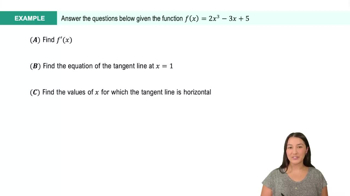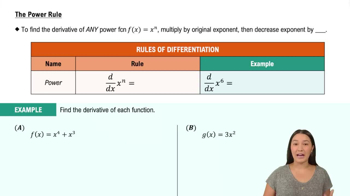Table of contents
- 0. Functions7h 52m
- Introduction to Functions16m
- Piecewise Functions10m
- Properties of Functions9m
- Common Functions1h 8m
- Transformations5m
- Combining Functions27m
- Exponent rules32m
- Exponential Functions28m
- Logarithmic Functions24m
- Properties of Logarithms34m
- Exponential & Logarithmic Equations35m
- Introduction to Trigonometric Functions38m
- Graphs of Trigonometric Functions44m
- Trigonometric Identities47m
- Inverse Trigonometric Functions48m
- 1. Limits and Continuity2h 2m
- 2. Intro to Derivatives1h 33m
- 3. Techniques of Differentiation3h 18m
- 4. Applications of Derivatives2h 38m
- 5. Graphical Applications of Derivatives6h 2m
- 6. Derivatives of Inverse, Exponential, & Logarithmic Functions2h 37m
- 7. Antiderivatives & Indefinite Integrals1h 26m
- 8. Definite Integrals4h 44m
- 9. Graphical Applications of Integrals2h 27m
- 10. Physics Applications of Integrals 2h 22m
3. Techniques of Differentiation
Basic Rules of Differentiation
Problem 78
Textbook Question
Derivatives from a graph Let F = f + g and G = 3f - g, where the graphs of f and g are shown in the figure. Find the following derivatives. <IMAGE>
F'(2)
 Verified step by step guidance
Verified step by step guidance1
Step 1: Understand the problem. We need to find the derivative of the function F at x = 2, where F = f + g. This means we need to find F'(2).
Step 2: Use the linearity of derivatives. The derivative of a sum is the sum of the derivatives. Therefore, F'(x) = f'(x) + g'(x).
Step 3: Evaluate the derivatives at x = 2. We need to find f'(2) and g'(2) from the graph of f and g.
Step 4: Analyze the graph. Look at the slope of the tangent line to the graph of f at x = 2 to find f'(2), and do the same for g to find g'(2).
Step 5: Substitute the values. Once you have f'(2) and g'(2), substitute them into the equation F'(2) = f'(2) + g'(2) to find the derivative of F at x = 2.
 Verified video answer for a similar problem:
Verified video answer for a similar problem:This video solution was recommended by our tutors as helpful for the problem above
Video duration:
5mPlay a video:
Was this helpful?
Key Concepts
Here are the essential concepts you must grasp in order to answer the question correctly.
Derivative
A derivative represents the rate of change of a function with respect to its variable. It is defined as the limit of the average rate of change of the function as the interval approaches zero. In graphical terms, the derivative at a point corresponds to the slope of the tangent line to the curve at that point.
Recommended video:

Derivatives
Sum and Difference of Functions
When dealing with the sum or difference of two functions, the derivative can be computed using the sum and difference rules. Specifically, if F = f + g, then F' = f' + g', and for G = 3f - g, G' = 3f' - g'. This allows us to find the derivatives of composite functions by differentiating each component separately.
Recommended video:

Introduction to Riemann Sums
Evaluating Derivatives at Specific Points
To find the derivative at a specific point, such as F'(2), one must first compute the derivative function and then substitute the given value into this function. This process often involves analyzing the graphs of the functions involved to determine their slopes at the specified x-value, which can be visually interpreted from the graph.
Recommended video:

Critical Points

 3:59m
3:59mWatch next
Master Derivatives of Linear Functions with a bite sized video explanation from Callie
Start learningRelated Videos
Related Practice







